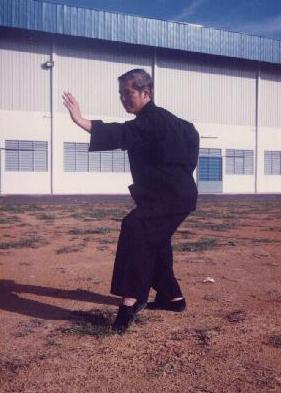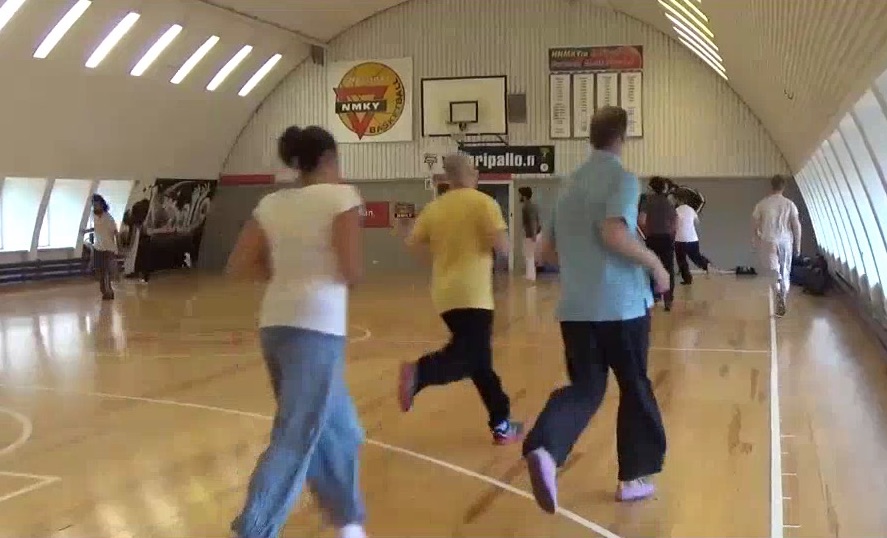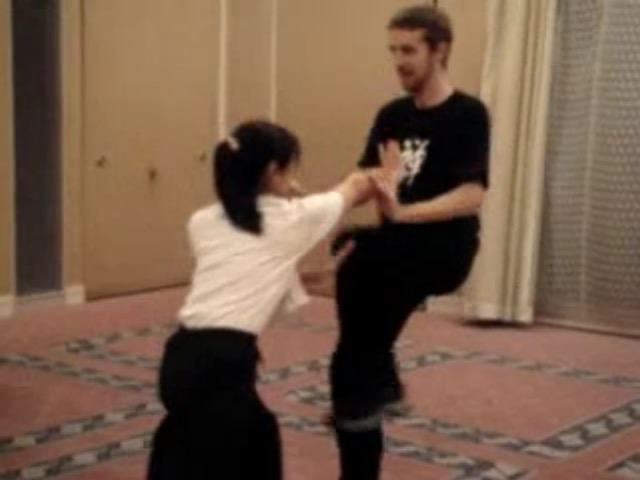SELECTION OF QUESTIONS AND ANSWERS
NOVEMBER 2018 PART 3

Chi flow is an excellent method to overcome illness
Question 1
Someone is the manager of a company but he is sick. He practices chi kung to have mental clarity so that he can attain peak performace in his work. Is it correct?
— Herman, Switzerland
Answer
No, it is not correct. The manager should overcome his illness first. If he tries to attain peak performance by having better mental clarity, he is unlikely to succeeed. His illness will affect his mental clarity and peak performance. He upsets the natural way of chi operation.
The natural way of chi operation, which he can achieve by following the concept of "wu-wei" or spontaneity, is that his chi kung practice will first overcome his illness, then enhance his performance.
Question 2
When I move fast, my breathing rate also becomes fast. How can I overcome this problem?
— Sofia, Spain
Answer
For untrained persons, their fast movements will spontaneously increase their rate of breathing. When their movements are very fast, their breathing may not be able to cope with the fast movements. Hence, they are out of breath.
An excellent way to train to be fast yet not panting for breath is to maintain the breathing rate when we gradually increase the number and speed of movements. We practice this method at the Intensive Shaolin Kungfu Course.
At first, there is one breath for one movement. Then we increase the number and speed of movements but maintain the one breath. We usually use the set, "Lohan Asks the Way", to do this.
There are 4 sequences, with 8 patterns per sequence, in the set. First we perform the set pattern by pattern, with one breath per pattern, which means we use 32 units of time to complete the set of 32 patterns. For easy reference, if we use one second for each unit of time, we use 32 seconds to complete the set.
There are actually 36 patterns in the set, with 2 patterns at the beginning and 2 patterns at the end for greeting. But for our training, we can temporarily leave out the greeting patterns. For this developmental stage, where we use one breath for one pattern, we focus on picture-perfect form.
When we can perform the set at this stage to our satisfaction, we proceed to the next stage, where we increase the number of patterns for each breath. We can use 1 breath for 4 patterns, which means we can complete the set of 32 patterns in 8 seconds.
Previously we used 32 seconds to complete the set, now we use only 8 seconds. We increase the speed of our performance without scarifying the form, but we do not increase our breathing rate. Our movements, therefore become faster, but our breathing rate remains the same.
Next, we use 1 breath for 8 patterns, which is 1 breath for one sequence. In reality, because of some breathing structures, we do not exactly use 1 breath for 1 sequence every time, but it is mentioned here for easy understanding. We can then complete the whole set in 4 seconds without being tired and without panting for breath. We increase the speed of movement but maintain the same rate of each breath.
Another excellent method is the Art of Thousand Steps. We increase our rate of movement without increasing the rate of breathing. In this art, we breathe in 100%, breathe out 70%, and swallow 30%. At the end of our running, which is more than a thousand steps, we have more energy than before. We can be very fast but without being tired and without panting for breath.
We can use the same principle, i.e. increasing our speed but without increasing our breathing rate, for any chi kung or kungfu exercise, or any activity. This is an excellent way to overcome the problem of increasing the speed of movement without the breathing becoming fast. But the training must be done under a master. Learning on one's own is not only unlikely to be successful but also may bring harm.

Lohan Asks the Way
Question 3
A lot of comments saying that no woman could beat the strongest man or just any athletic man in general because men are stronger, faster, quicker, and have better reflexes. Personally I find the claim that a woman not being able to defeat a man in combat to be completely absurd and a by-product of ignorance and naiveness.
— Nareshwar, India
Answer
Generally men are stronger than women. Hence, if all other things were equal, men are better fighters. But if a woman has learned a martial art well -- a genuine martial art that she can use for fighting, not the types of martial arts that we find nowadays where practitioners generously exchange blows -- she would be able to beat an untrained man. If she has trained in internal force, like in good kungfu, she can be stronger than men, irrespective of her age and size.
There were many famous woman kungfu masters in history, like Ng Mui, Miu Choi Fa, Yim Wing Choon and Li Chui Ping. Men were nowhere compared to them. Even the famous Pak Mei, who was a kungfu genius, was scared to fight with Ng Mui.
There are also many female kungfu practitioners in our school who have internal force. Honestly, many men would be badly beaten by these women, who are also gentle and graceful.
However, in kungfu history there were overwhelmingly more man fighters than woman fighters, even when the women, if they were lucky, could train internal force. This was because of culture, rather than combat efficiency. In modern society, for example, there are still more women than men as nurses.
Question 4
In your opinion how does the use of chi help a person? I am aware that knowledgeable and skillful use of chi can make a person stronger and healthier, along other countless spiritual benefits, regardless of sex, size, and age. But what about speed, agility, and reflexes? Does it do anything to help that?
Answer
A knowledgeable and skillful use of chi certainly helps a person, irrespective of his (or her) sex, size and age, in countless ways, such as to be stronger, healthier, have more spiritual benefits like being peaceful and happy, achieve better performance in daily life, as well as in fighting.
A knowledgeable and skillful use of chi also helps to increase speed, agility and reflexes. The video here shows how course participants used chi to generate speed. I am now over 70 years of age, but I can still roll and jump, which show my agility. The video here shows course participants, being blind-folded, use reflexes to sense opponents' attack which indicates fast and accurate reflexes.
It is worthy to emphasize that the use of chi for these benefits must be knowledgeable and skillful. There were kungfu masters in the past who had a lot of chi, or energy, but because they lacked knowledge and skills, they were unable to use their chi for these purposes. Students in our school are very lucky. We share our knowledge and skills of chi with them.

The Art of Thousand Steps
Question 5
Did you invent Cosmic Shower?
— Michael, Switzerland
Answer
No, I didn't. There was a very high level Taoist art called "Opening of Five Golden Flower" with similar effects at its beginning stage as our Cosmic Shower. This Taoist art was for spiritual cultivation to cultivate the spirit, called "heavenly fetes", to emerge as an immortal from the "baihui" energy point at the crown of the head. It would take at least 20 years.
The first part of the training, which would take a few years, was similar to our Cosmic Shower. The art generated cosmic energy to cleanse the body and spirit before emerging as an immortal.
In my own chi kung training, I also experience effects of Cosmic Shower. I found streams of energy like electricity or sometimes like warm water flowing down my body. Later I discovered that these streams of energy also nourished me besides cleansing.
When I first taught the art, I used the term "Golden Shower". Riccardo Salvatore from Portugal told me that "Golden Shower" might have some negative connotation, so I changed it to "Cosmic Shower".
Terms like "physical, emotional, mental and spiritual" cleansing and nourishing were first used by me. These terms were borrowed from Western culture. I believe that originally the effects of Cosmic Shower in "Opening of Five Golden Flowers" were cleansing, though they might also be some incidentally nourishing.
I experienced the effects of Cosmic Shower after many years of chi kung training. Certainly they are not accomplished in a few hours of our present Cosmic Shower course.
Question 6
In the "Art of Thousand Steps", do we still maintain the breathing method when we have stopped running?
— Francis, Spain
Answer
When we have stopped running in the Art of Thousand Steps, we can still use the same breathing method or we can revert to our normal breathing method. Either way will do.
It is good to know that there are two dimensions to the special breathing method for the Art of Thousand Steps. In the first dimension, people normally breath in 100% and breath out 100%. In the Art of Thousand Steps, we breathe in 100%, breath out 70% and swallow 30%. After running, we have more energy than before.
In the second dimension, we maintain the same rate of breathing irrespective of the speed of our action. Most people breathe about 10 times a minute. Chi kung practitioners breathe about 5 times a minute. Those taking the Art of Thousand Steps may breathe only 2 times a minute. Their breathing is slow and deep.
For most people, when their action is fast, their rate of breathing also becomes fast. Instead of breathing 10 times a minute in their normal way, the breathing rate may increase to 50 times or more per minute. They then become out of breath. But practitioners of the Art of Thousand Steps maintain their normal rate of breathing even when their action has become fast. They still breath at 2 times per minute even when they are running very fast. Hence, they are never out of breath.
How do practitioners of the Art of Thousand Steps not become tired? They are relaxed and use their chi for running. Other people become tired because they use their muscles. Not only practitioners of the Art of Thousand Steps not out of breath and not tired in running, they are also not out of breath and not tired in all their physical and intellectual work.

Sifu Naoko, our woman fighrer free sparring with a hefty man
Question 7
You mentioned about neigong in the course on "Developing Internal Force using the Triple-Stretch Method". What is the difference between chi kung and neigong?
— Sifu Roland Mastel, Switzerland
Answer
"Chi kung", is a modern term. "Neigong" was used in the past. "Chi kung" was also used in the past, but was not popular. The term became popular in the 20th century.
"Chi kung", or "qigong" in Romanized Chinese, means "energy art", and "neigong" means "internal art". Both terms meant about the same thing, though "chi kung" was more basic and usually for health, and "neigong" was more advanced and for martial arts. Today, however, when we mention "chi kung", many people have the concept of some gentle physical exercise.
What we practice in our school is more appropriately described as "neigong", which is not only genuine chi kung rather than just some gentle physical exercise, but advanced genuine chi kung. But we still use the term "chi kung" for the sake of the public. If we use "neigong" we may have to explain the term to many people.
There is a kungfu saying as follows. "Nei lian jin shen qi; wei lian ken gu bei" which means "internally train elegance, mind and energy; and externally train sinew, bones and muscles". Both neigong and chi kung train elegance, mind and energy.
Question 8
In the Sinew Metamorphosis course you mentioned about the tiger-form. Is there any significance of the Tiger in Sinew Metamorphosis?
Answer
I mentioned the Tiger because Sinew Metamorphosis generates a lot of internal force, and the Tiger is related to internal force. In the Shaolin "five animals", which are the Dragon the Snake, the Tiger, the Leopard and the Crane, the Tiger represents "gu", which literally means "bone", but figuratively it means internal force.
The Dragon represents "shen", or "mind". The Snake represents "qi", or "energy". The Leopard represents "li", or "strength". The Crane represents "jing", or "elegance".
Many people, including some masters, think that when you train tiger-forms, you develop strong bones. Developing strong bones is only one of many aspects. Your bones may not literally become bigger, but they become strong as they are charged with internal force. Actually, here "gu" means "internal force".
Although the Tiger is important in Sinew Metamorphosis, the main feature is "shen" or "mind", represented by the Dragon. Without the mind being free of irrelevant thoughts, a practitioner cannot generate any internal force.
If you have any questions, please e-mail them to Grandmaster Wong via his Secretary at secretary@shaolin.org stating your name, country and e-mail address.
LINKS
Selected Reading
- Chi Kung: the Art of Developing Energy
- The Grace of God Flowing through Us.
- The Risk of Practicing Iron Wire if you Practice Wrongly
- Sun Style Taijiquan Set
- Beautiful Carolina
